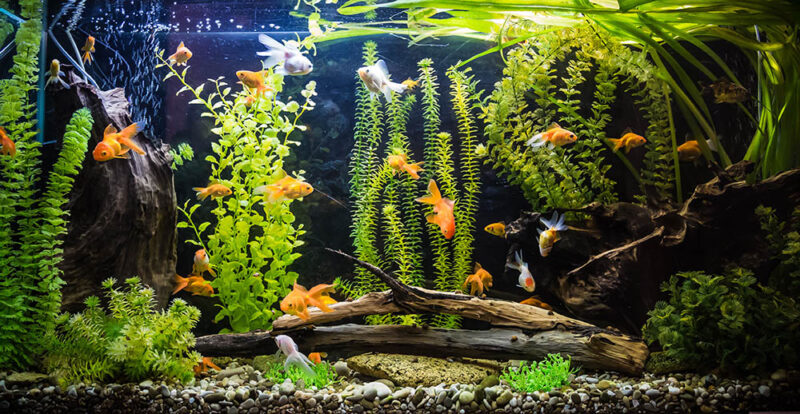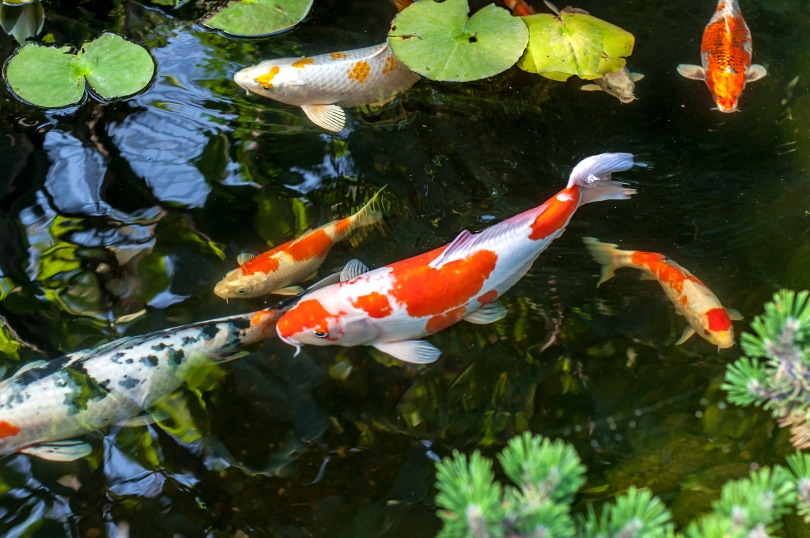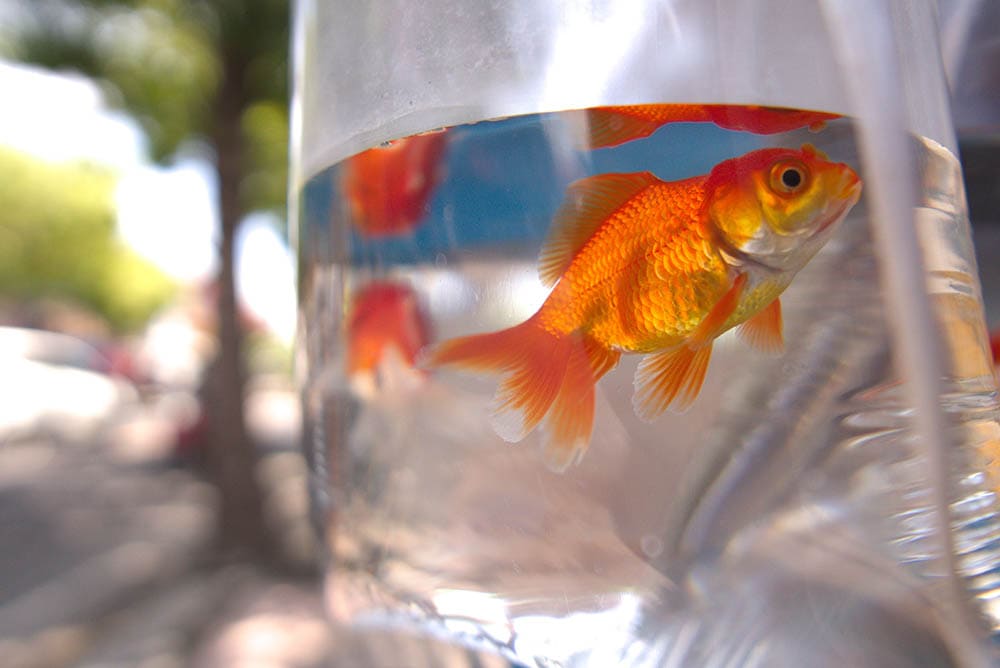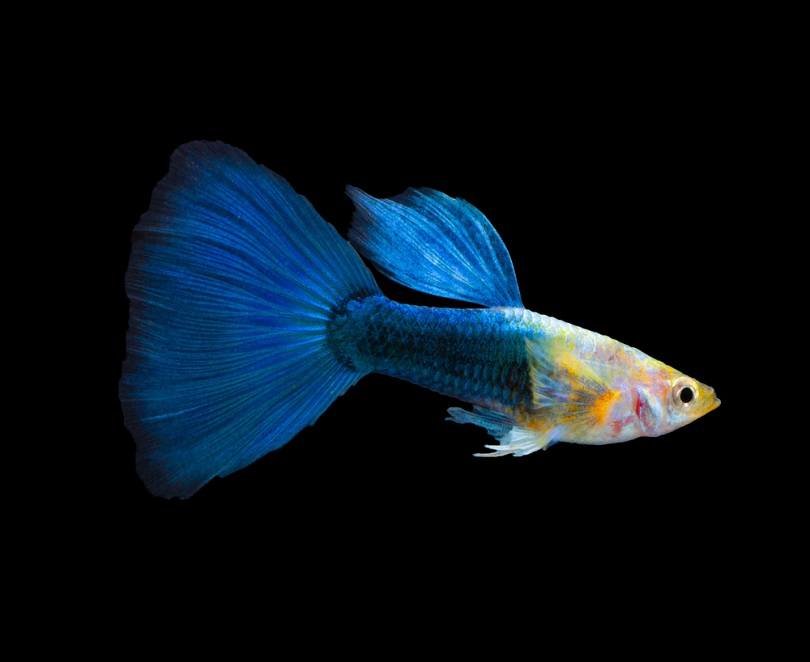
Click to Skip Ahead
Swordtails are popular live-bearing fish belonging to the Poeciliidae family. They are related to other live-bearing fish like Mollies or Platies and share a similar appearance and temperament. As their name suggests, Swordtails stand out with their long caudal fin extension which resembles a sword. However, only males have sword-like tails, and the females are quite plain in comparison.
| Size: | Up to 5.5 inches long |
| Lifespan: | 3–5 years |
| Similar Breeds: | Mollies, Platies, and Guppies |
| Suitable for: | Beginner fishkeepers |
| Temperament: | Social, timid, adaptable, hardy, and peaceful |
Both beginner and experienced fishkeepers will find it easy to raise and care for Swordtail fish. They are considered hardy and adaptable while being relatively low maintenance. Swordtails get along with many other tank mates, making them ideal for peaceful additions to community aquariums. Furthermore, Swordtails can be found in a wide range of colors and patterns which help make them look striking.
If you are interested in caring for Swordtails in your aquarium, this article will cover the most important aspects of their care that you should know.
Swordtail Fish Cost
Swordtails originate from Central America, specifically from Mexico, Guatemala, Veracruz, and Honduras. They are typically found in tropical freshwater ponds, ditches, springs, and river systems. However, they can also be found in brackish waters, which is why they are considered highly adaptable fish. Since the 1900s, Swordtails have been used by scientists for genetic studies and research. Swordtails are widely available from many pet stores, breeders, and online retailers. There is no shortage of these fish, and they have been part of the aquarium trade for decades.
Fortunately, Swordtails are not very expensive and usually cost between $3 to $15 per fish. Some pet stores may offer a discounted price for a group of Swordtails since they are social fish that need to be kept in groups of five or more.
Sociability of the Swordtail Fish
Do These Fish Make Good Pets?
Swordtails make excellent pets for fishkeepers regardless of their experience level. Aside from their stunning appearance, one of the major factors that draw people to Swordtails is their ease of care. Swordtails are not difficult to care for, which is part of the reason they are hardy fish. They are more forgiving of beginner fishkeeper mistakes, although they still require the proper living conditions to thrive.
Does This Fish Make a Good Tankmate?
Swordtails are highly social and make good tank mates for other peaceful and social community fish or invertebrates. Before you keep Swordtails with tank mates, you first need to ensure that you are keeping your Swordtails in at least a group of five or six. Swordtails enjoy the company of their species and can get stressed when kept alone.
However, they do not form schools like other social fish would and do not have synchronized swimming patterns. You will notice that Swordtails become more secure and active when kept in groups, and much less timid than if they were alone.
Other good tank mates for Swordtails include small and peaceful fish that can live in the same water conditions. Their compatible tank mates need to thrive at a similar water temperature, pH range, and setup. Swordtails are considered incompatible with large and aggressive tank mates, or ones that cannot live at the same water parameters.
| Compatible Tank Mates: | Incompatible Tank Mates: |
| Mollies | Goldfish |
| Guppies | Oscars |
| Neon Tetras | African Cichlids |
| Freshwater Snails | Koi |
| Corydoras | Jack Dempsey |
| Platies | Red-tailed Shark |
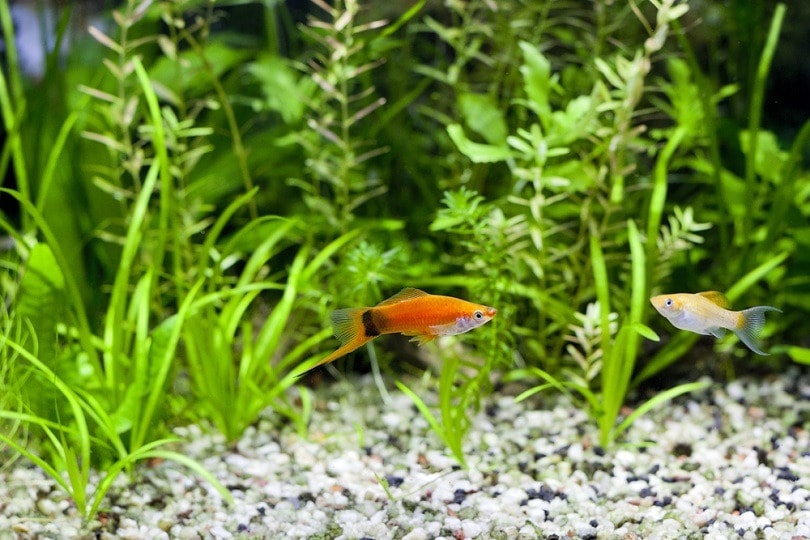
Care Guide & Tank Set Up
Let’s discuss how you can properly care for your Swordtails in an aquarium.
The minimum tank size for a small group of Swordtails starts at 20 gallons. If you plan to keep more than six of them together or with tank mates, the tank size needs to be upgraded accordingly.
Water Quality, pH & Temperature
Keeping Swordtails healthy and happy in aquariums is possible by ensuring their water quality and conditions are ideal. Like other aquarium fish, the Swordtails’ health depends on their water quality and tank conditions. They are freshwater fish that need to be kept in cycled aquariums with mature water parameters. This means that their water should have no traces of ammonia or nitrite, but nitrates are tolerable till 20 ppm.
Ideally, you want to keep their tank heated between 72 to 82 degrees Fahrenheit to replicate the tropical conditions they experience in the wild. The temperature shouldn’t fluctuate too much since this is stressful for Swordtails. The water’s pH range should fall between 7.0 to 8.0, and the water hardness around 12 to 30 dGH.

Substrate
Most types of aquarium substrates are safe to use in Swordtail aquariums, including sands, gravel, and quartz. The substrate should not alter the pH or hardness of the water and have a few toxic properties like dyes that could leach into the water. The best substrates to use in your Swordtails aquarium would be natural-colored sand and gravel.
Plants
Swordtails enjoy exploring aquariums with live plants like java moss, hornwort, anubias, and dwarf hair grass. However, they are not fussy about having fake or live plants in their aquarium. Live plants are often preferred as they create a natural environment for Swordtails while offering filtration and oxygenation benefits. Most Swordtails will leave live plants alone and rarely eat them if they are being fed an appropriate diet.

Lighting
Aquarium lighting is important for Swordtails during the daytime to create a day-and-night cycle. Most Swordtails are active during the day, although some may show more nocturnal qualities. They should receive 6 to 10 hours of low to moderate lighting per day, and a period of darkness at night. Avoid using bright lighting in your Swordtails aquarium, since this can be stressful and unnatural for them.
Filtration
Aside from a heater, a filter is a necessity for Swordtail aquariums. A filter prevents their aquarium water from becoming stagnant while helping to process the waste products. You can run various types of filters in their aquarium, although sponge and internal filters are more popular. The filter should be able to filter the number of gallons in the tank every hour and produce slow to moderate current. Swordtails do not enjoy swimming against strong water currents and will try to hide away once they get tired.

Things to Know When Owning a Swordtail Fish
Food & Diet Requirements
Swordtails eat an omnivorous diet in the wild and in captivity. Their wild diet generally consists of worms, algae, plants, insects, and crustaceans. In captivity, the basis of a Swordtail’s diet should be a high-quality flake, pellet, or granule food formulated for tropical fish. You can offer them sinking algae or spirulina wafers as an occasional treat a few times a week. Bloodworms, baby brine shrimp, and daphnia are excellent protein-rich foods that Swordtails will gladly eat up to three times a week.
You should aim to feed your Swordtails at least once a day, and as much food as they can all eat within 3–5 minutes.
Size & Growth Rate
Swordtails are not very large fish and usually grow between 3.5 to 5.5 inches long. The male Swordtail’s elongated caudal fin makes them appear longer than they actually are. It takes up to 6 months for a Swordtail to become fully grown in captivity, although they are sexually mature at 3 to 4 months old. Swordtails grow rapidly with a proper diet and good water conditions. Be sure to keep them in a well-maintained aquarium and feed them a healthy and balanced omnivorous diet.
Varieties
There are around 52 different species of fish belonging to the Xiphophorus genus, but only 17 of them are Swordtails. The main species kept in captivity is the X. helleri, commonly known as the Green Swordtail.
Swordtails are characterized by their slender bodies, single dorsal, anal, and caudal fins, and pairs of ventral and pectoral fins. The males stand out with their sword-like caudal fin that is non-existent in females.
Common variations of Swordtails include:
Swordtails do not disappoint when it comes to color, and they can be found in striking reds, oranges, white, black, yellows, greens, and blues.

Lifespan and Health Conditions
Swordtails have a short average lifespan between 3 to 5 years. Their lifespan can be longer or shorter depending on their overall care, health, and water conditions. Good water quality is essential for a Swordtail’s health and longevity. Poor water quality not only makes them susceptible to ammonia or nitrite toxicity but also to certain health conditions.
Male vs Female
The easiest way to distinguish between male and female Swordtails is by looking at their caudal (tail) fins. Male Swordtails have the sword extension and an elongated gonopodium, which females lack. The male Swordtails are generally longer than the females who have a rounded and wider body shape. The rounded abdomen is most noticeable in female Swordtails over 4 months old.
3 Little-Known Facts About Swordtails
1. Swordtails do not lay eggs to reproduce.
Swordtails are live-bearing fish that do not lay eggs but rather give live birth to free-swimming offspring.
2. Swordtails have been used for scientific research purposes since the early 1900s.
Swordtail fish have been used in studies focused on melanoma research caused by DNA damage by UV radiation.
3. Male Swordtails are the only ones with the distinctive caudal fin extension.
Male and female Swordtails are easy to differentiate. The males have an elongated caudal fin that has earned them the name Swordtail. Females do not have this sword-like extension, which is why they are often mistaken for Platies or Mollies.
Final Thoughts
Swordtails are beginner-friendly aquarium fish that are named after the elongated caudal fin extension seen in males. They are live-bearing fish that are relatively easy to care for while being low-maintenance pets. Swordtails are ideal for community aquariums, or they can be kept in a species-only tank. Their peaceful and social temperament makes them compatible with other fish like Guppies and Corydoras, or invertebrates like Mystery Snails. They are available in many different varieties, such as pineapple, marbled, and speckled.
You can successfully raise happy and healthy Swordtails in your aquarium by keeping them in groups and in a spacious aquarium with good water quality. With proper care and aquarium conditions, Swordtails can live for up to 5 years.
See also:
- Rosy Barb: Care Guide, Pictures, Tank Setup, and Info
- Silver Dollar Fish: Care Guide, Pictures, Tank Setup & Info
Featured Image Credit: panpilai paipa, Shutterstock





